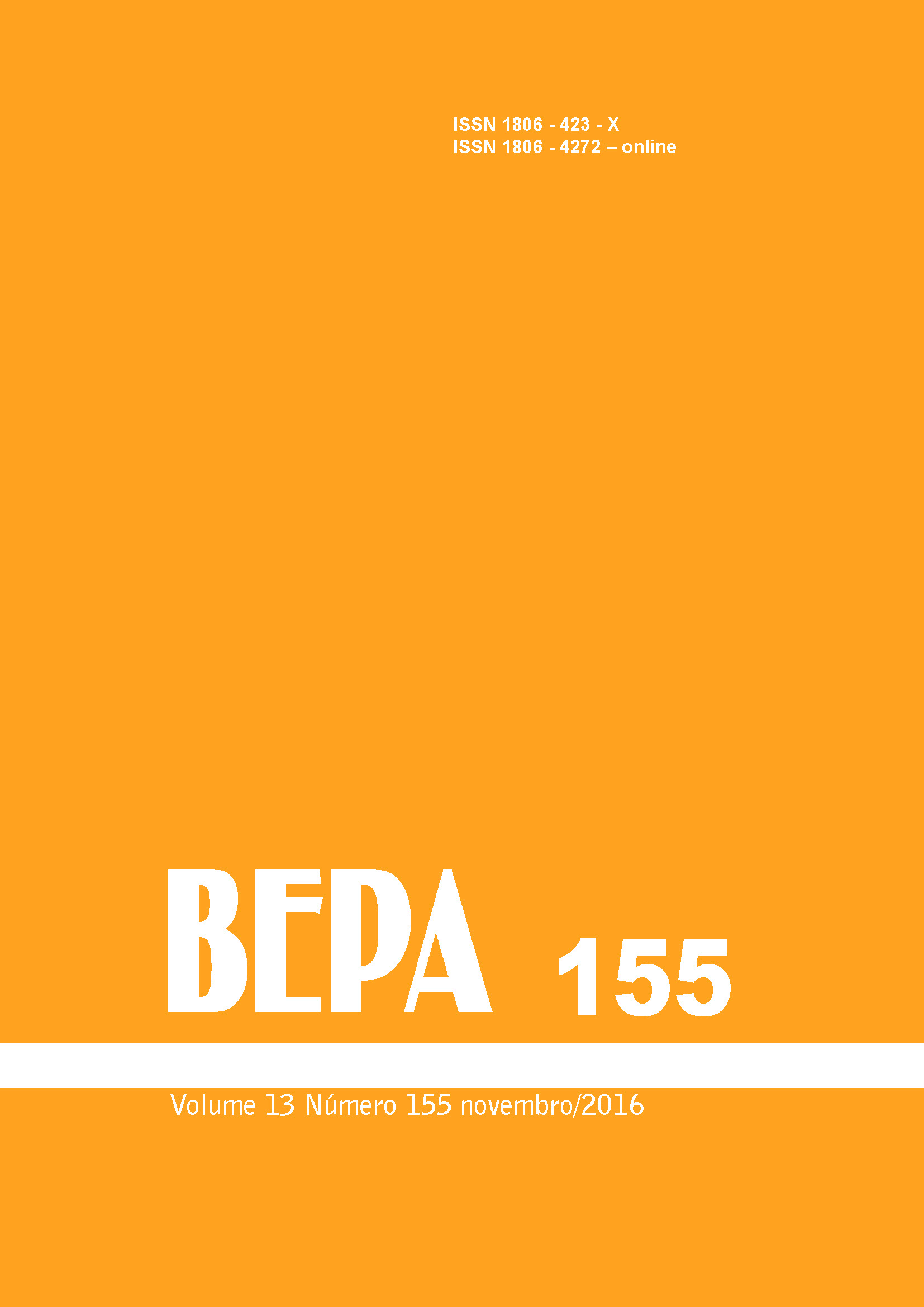Abstract
In Brazil, the incidence and mortality rates of cervical cancer are still high,
and the analysis of its frequency represents an essential component of the
health surveillance programs. Data from IBGE indicate the Vale do Ribeira
as the region with the lowest HDI of São Paulo State, which is considered
as a risk factor for developing pre-neoplastic lesions. This study describes
the relative and absolute frequencies of the cervicovaginal cytopathological
results in women according to the age group attended at Health Units of Vale
do Ribeira. A total of 27,666 pap smears were performed between 2014 and
2015 in the Cytopathology Laboratory of Adolfo Lutz Institute, being 24,398
(88.20%) negative; 558 (2.00%) unsatisfactory; 1,725 (6.24%) ASC-US,
522 (2.00%) LSIL; 160 (0.58%) ASC-H; 143 (0.52%) HSIL; 14 (0.05%)
carcinoma; 102 (0.37%) AGC-SOE; 11 (0.04%) AGC-NEO, and 3 (0.01%)
adenocarcinoma. Of the total, 78.5% of the tests were performed in women
in the age range recommended by the Brazilian guidelines (25-64 years old).
Women bellow 24 years old showed a highest frequency of ASC-US and
LSIL. The HSIL cases were more frequent in women from 25 to 29 years
old, and a higher frequency of carcinoma was observed in women from 30
to 34 years old. The frequency of precursor lesions, the age range with major
occurrence and the identification of particular characteristics of the attended
population give supports to direct the health actions, resulting in benefits to
the women undergoing to the cervical cancer screening procedure.
References
World Health Organization (WHO).Comprehensive cervical cancer control: aguide to essential practice. Switzerland; 2014.
Ministério da Saúde, Instituto Nacional deCâncer José Alencar Gomes da Silva (INCA).Estimativa 2016: incidência de câncer noBrasil. Rio de Janeiro; 2016. [internet].[acesso em 13 fev 2016]. Disponível em:http://www.inca.gov.br/estimativa/2016
Ministério da Saúde, Instituto Nacionalde Câncer José Alencar Gomes daSilva (INCA). Manual de gestãoda qualidade para laboratório decitopatologia. Rio de Janeiro; 2012.
Ministério da Saúde, Instituto Nacionalde Câncer José Alencar Gomes da Silva(INCA). Diretrizes brasileiras para orastreamento do câncer do colo do útero. 2ªed Rev Atual. Rio de Janeiro: INCA; 2016.
Navarro C, Fonseca AJ, Sibajev A,Souza CIA, Araújo DS, Teles DAF et al.Cobertura do rastreamento do câncer decolo do útero em região de alta incidência.Rev Saúde Pública. 2015;49:17.
Sadovsky ADI, Poton WL, Reis-SantosB, Barcelos MRB, Silva ICM. Índice dedesenvolvimento humano e prevençãosecundária de câncer de mama e útero:um estudo ecológico. Cad. SaúdePública, 2015;31(7):1539-50.
Andrade MS, Almeida MMG, Araújo TM,Santos KOB. Fatores associados a nãoadesão ao Papanicolaou entre mulheresatendidas pela Estratégia Saúde daFamília em Feira de Santana, Bahia, 2010.Epidemiol. Serv. Saúde. 2014;3(1):111-20.
Protocolo do método manual BDSurePathTM, Papanicolaou em meio líquido.In: BD PrepstainTM System: guia resumidopara treinamento técnico do usuário, 2008.
Ministério da Saúde, Instituto Nacionalde Câncer, Coordenação de Prevençãoe Vigilância. Nomenclatura Brasileirapara laudos citopatológicos e condutaspreconizadas: recomendações paraprofissionais de saúde. 2.ed. Riode Janeiro: INCA; 2006.
Merckx M, Benoy I, Meys J, Depuydt C,Temmerman M, Weyers S, Vanden Broeck,D. High frequency of genital humanpapillomavirus infections and related cervicaldysplasia in adolescent girls in Belgium.Eur J Cancer Prev. 2014, 23(4): 288-93.
Rosa M, Mohommadi A. Cervical cytologyand Human Papillomavirus testing inadolescent women: implications inmanagement in management of a positiveHPV test. Patholog Res Int. 2014,1-4.
Wright Jr TC, Thomas Cox J, Stewart MassadL, Carlson J, Twiggs, LB, Wilkinson, EJ. 2001Consensus Guidelines for the managementof women with cervical intraepithelialneoplasia. AJOG. 2003, 189(1): 295-304.
Guo F, Hirth JM, Berenson AB. Cervicalcancer screening among women ≥ 70 years ofage in the United States-A referral problem orpatient choice. Prev Med. 2015; 81:427-32.
Abdullah NK, Daud S, Al-Kubaisy W, Saari,IS, Saad SR. Cervical cancer screeningafter 50: near extinction? Eur J ObstetGynecol Reprod Biol. 2016;206:136-40.
Zaabi MA, Muqbali SA, Sayadi TA, AmeeriSA, Coetsee K, Balayah Z, Ortashi O.Age specific cytological abnormalities inwomen screened for cervical cancer in theEmirate of Abu Dhabi. Asian Pacific Journalof Cancer Prevention. 2015,16:6375-9.
Ciesielska U, Nowinska K,Podhorska‑Okolow M, Dziegiel P.The role of human papillomavirus inthe malignant transformation of cervixepithelial cells and the importance ofvaccination against this virus. AdvClin Exp Med. 2012, 21(2):235-44.
Cuvelier CA, Bogers JP, Bourgain C,Delvenne P, Drijkoningen M, Garbar C,Kevers M, Remmelinck M, Thiepnt L,Verhest A, Weynand B, Willocx F. Belgianconsensus guidelines for follow-up of womeneith cervical cytological abnormalities.Acta Clin Belg. 2009, 64 (2): 136-43.
Bosoteanu M, Bosoteanu C, Deacu M, AschieM. The importance of monitoring protocolsin cervical carcinoma screening. Rom JMorphol Embryol. 2011;52(1):297-302.
Eversole GM, Moriarty AT, SchwartzMR, Clayton AC, Souers R, FathereeLA et al. Practices of participants inthe College of American PathologistsInterlaboratory comparison programin cervicocaginal cytology, 2006. ArchPathol Lab Med. 2010, 134:331-5
Nygärd JF, Skare GB, Thoresen SO.The cervical screening programme inNorway, 1992-2000: changes in Papsmear coverage and incidence of cervicalcancer. J. med. screen. 2002;9(2):89-91.
NHS Cancer Screening Programmes. NHSCervical Screening Programme StatisticalBulletin (England 2010-11). [internet].[acesso em 2 dez 2011]. Disponívelem: http://www.can-cerscreening.nhs.uk/cervical/statistics.html
Batista MLS, Cintra ACF, Santos JPC,Martins PD, Ribeiro AA, Tavares SBN etal. Resultados citopatológicos de mulheresque realizaram exame do colo do úteroem um laboratório escola da UniversidadeFederal de Goiás, GO: estudo de prevalência.J Health Sci. Inst. 2012;30(3):201-5.
Silva DSM, Silva AMN, Brito LMO,Gomes SRL, Nascimento MDSB,Chein MBC. Rastreamento do câncerdo colo do útero no Estado doMaranhão, Brasil. Ciênc. saúdecoletiva. 2014;19(4):1163-70.
Coelho CMC, Verde RMCL, OliveiraEH, Soares LF. Perfil epidemiológicode exames citopatológicos realizadosno município de Floriano, Piauí. Rev.Bras. Farm. 2014;95(1):459-73.
Sasieni P, Castañon A, Cuzick J. What isthe right age for cervical cancer screening?Women´s Health. 2010;6(1);1-4.

This work is licensed under a Creative Commons Attribution 4.0 International License.
Copyright (c) 2016 Daniela Etlinger-Colonelli, Sandra Lorente
